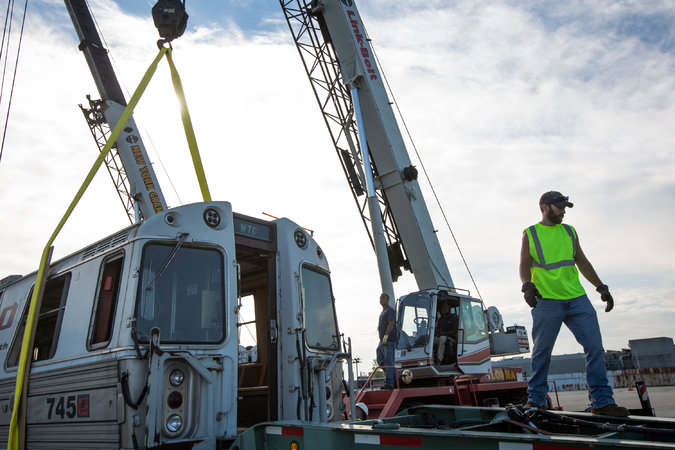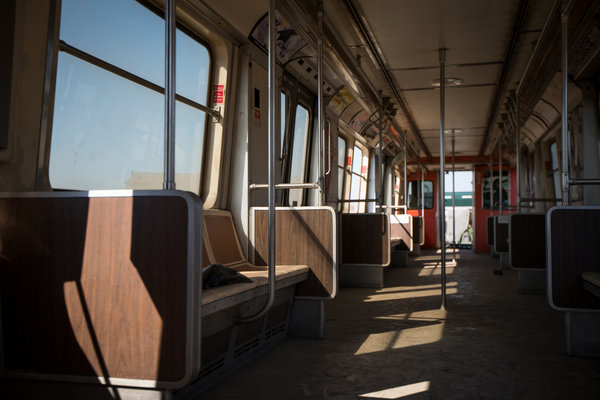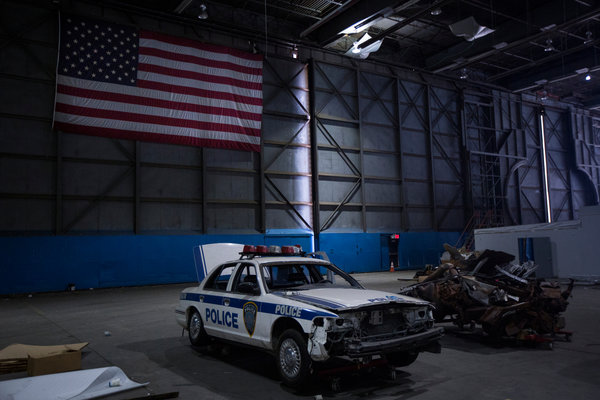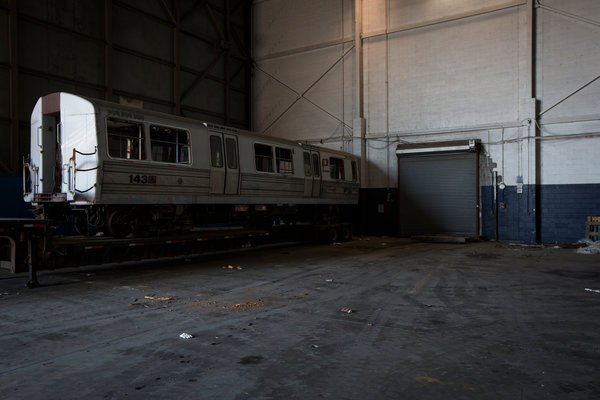David W. Dunlap New York Times
A perilous, improbable rail journey that began at the World Trade Center on September 11, 2001, will end Thursday when PATH car No. 745 is welcomed with a parade — bagpipes, dignitaries and all — through the streets of East Haven, Conn.

PATH car No. 745 was hauled out of Hangar 17 at Kennedy Airport on Tuesday, and lifted by two cranes onto a trailer truck. CreditMark Kauzlarich/The New York Times
No. 745 is the astonishingly intact remnant of a seven-car PATH train that was waiting on Track 2 at the trade center terminal for a return trip to Hoboken, N.J., when all hell broke loose. The crew was evacuated safely.
Having survived the collapse of the twin towers, two cars from that train, Nos. 745 and 143, were salvaged by the Port Authority of New York and New Jersey. They have been kept ever since in Hangar 17 at Kennedy International Airport, waiting for a new home.
When the Shore Line Trolley Museum in East Haven learned this year that one of the 1970s-vintage PATH cars was available for its collection, it did not hesitate. The fact that the car had such a direct link to the 2001 attack made it irresistible.
“A number of people involved with the museum are first responders, so it hit a chord with them,” Bill Wall, the president emeritus, said on Tuesday as he watched No. 745 being loaded on a trailer truck for its journey to Connecticut.
The Port Authority donated the 51-foot-long, 37-ton rail car to the museum, but the museum is picking up the tab for the transportation, about $20,000.

Inside dusty car No. 745, with its orange walls, brown plastic bucket seats and wood-grain partitions. Credit Mark Kauzlarich/The New York Times
Inside the dusty car — with its orange walls, brown plastic bucket seats and wood-grain partitions — time has not simply frozen; it has invested some of the advertising cards with a chilling double significance:
“Get there by air.”
“Glowing embers waiting to ignite.”
“Ordinary people. Extraordinary adventure!”
Mr. Wall said the public would be allowed to walk through the car when it is fully installed at the museum next year. Car No. 745 will be kept indoors, he said.
The car was hauled out of Hangar 17 on Tuesday to an apron where two cranes waited, side by side. Workers wrapped slings around the front and back of the car. It was lifted off the back of the flatbed trailer on which it had been stored and lowered on to a trailer truck operated by Silk Road Transport of Arkport, N.Y.
Jim Keane, the general manager of operations safety at the Port Authority, was among those watching the transfer. “It’s nice that it will be seen by the public,” he said, “and that people can learn more about what happened that day.”
“It has a history much different than so many rail cars,” Mr. Keane said.

Other September 11 artifacts are also stored in Hangar 17, including Port Authority Police Department vehicles. Credit Mark Kauzlarich/The New York Times
That history began in 1972 in Thunder Bay, Ontario, where Hawker Siddeley Canada manufactured the PA-3 series of aluminum-bodied passenger cars for the Port Authority Trans-Hudson commuter railroad. On car No. 745, the axle-mounted odometer, or hubometer, registers 201,104 miles of travel.
All seven cars of the Hoboken-bound train were removed to Staten Island to be decontaminated and stripped of usable parts, according to the encyclopedic nycsubway.org. Only cars 745 and 143 wound up at Hangar 17.
Today, No. 143 looks quite small — almost toylike — tucked all by itself in a corner of the 1.8-acre hangar. It is part of an ever-shrinking inventory of artifacts that the Port Authority makes available for memorial sites and museums.
(For a time, steel artifacts were given away as political favors by Bill Baroni, the deputy executive director of the authority, who was appointed by Gov. Chris Christie of New Jersey. The program has since returned to professional control.)
Among the artifacts still available are 88 pieces of steel and 217 non-steel items, including aluminum cladding from the towers, large pieces of the antenna, Port Authority Police Department vehicles, elevator motors and items saved from the concourse-level shopping mall, like clothing, jewelry and toys.
“The artifacts program preserves the history and memorializes the lives of those we lost on 9/11,” said Erica Dumas, a spokeswoman for the authority.
It has also transformed workaday objects into resonant symbols.

Today, PATH car No. 143 is by itself in a corner of the 1.8-acre hangar. Credit Mark Kauzlarich/The New York Times
“For most people, this would be a subway car,” Mr. Wall said. “Now, it’s an icon.”

